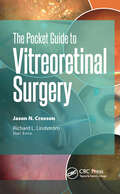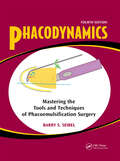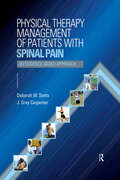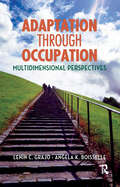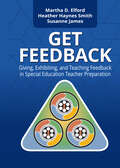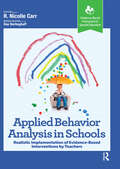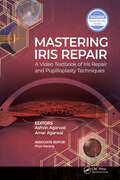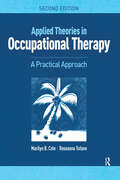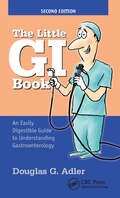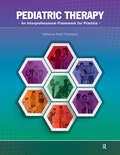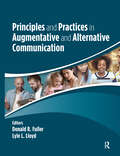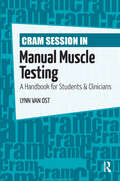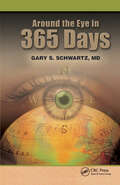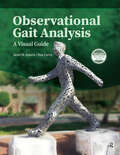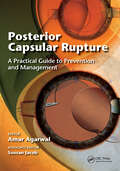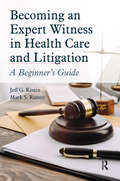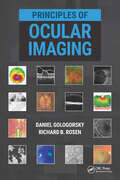- Table View
- List View
The Pocket Guide to Vitreoretinal Surgery (Pocket Guides)
by Jason CrossonAre you a medical student, resident, or fellow trying to absorb as much information on the basics of retina surgery as efficiently as possible? Are you a general ophthalmologist who needs a quick refresher on a complex procedure? Reach into your lab coat pocket and pull out The Pocket Guide to Vitreoretinal Surgery for easy access to the essential information you need right now. Dr. Jason N. Crosson and colleagues have designed this book as the ultimate quick-read manual on retina surgery, using a conversational tone that allows readers to retain information in the most effective manner. Medical students, residents, and fellows will be delighted to use this accessible, high-yield handbook during their rotations to familiarize themselves with the “nuts and bolts” of retina surgery, while general ophthalmologists will be glad to have it as a quick reference guide to current best practices. Each chapter in The Pocket Guide to Vitreoretinal Surgery is arranged in short, easy-to-read sections and accompanied by numerous color photographs to aid in recognition and retention. Among the topics covered: • Preoperative preparations • Basics of vitrectomy • Retinal detachment surgery • Macular surgery (Peeling 101) • Diabetic vitrectomy • Vitrectomy for endophthalmitis • Intraocular lens cases • Ocular trauma Eye care providers at all skill levels will benefit from the high-yield, quick-access information contained within The Pocket Guide to Vitreoretinal Surgery, whether they are preparing for their first surgeries or longtime physicians.
Phacodynamics: Mastering the Tools and Techniques of Phacoemulsification Surgery
by Barry S. SeibelWhat surgical advancements have spawned from the evolution of phaco technology? Join the thousands of surgeons who have utilized Phacodynamics: Mastering the Tools and Techniques of Phacoemulsification Surgery to understand and benefit from the advantages of phaco technology. The revised, expanded, and updated Fourth Edition of this classic text includes over 300 simple, yet elegant, figures and illustrations detailing the latest machine technologies and surgical techniques. Visual learners…In addition to examining the intricate relationship between the surgeon and the phaco machine, Dr. Barry Seibel profiles how the most recent advancements in machine technology can enhance your surgical procedures and optimize your results. With schematic figures and illustrations to accompany the detailed descriptions, surgeons can readily identify and distinguish between various flow pumps, vacuum pumps, and ultrasound power modulations. Surgery can then be customized moment by moment for each individual patient to maximize safety and efficacy.Phacodynamics, Fourth Edition utilizes a simplified approach to explain all the latest advancements in phaco technology and surgery and should be in the hands of all surgeons practicing in this specialized area.New topics included that are unique to this Fourth Edition:Bimanual Microincision Phaco Ultrasound Power Modulations including Burst and Pulse Modes AquaLase and Laser Surgical Technologies Expanded Horizontal Chopping Techniques including PreChop Vertical Chopping Techniques and Instrumentation Bimanual Irrigation and Aspiration Phacodynamic Complications Phacodynamics of Surgical Instrument Design
Physical Therapy Management of Patients with Spinal Pain: An Evidence-Based Approach
by Deborah Stetts Gray CarpenterIn this rapidly changing health care environment, a challenge today’s physical therapist faces is finding, evaluating, and implementing current best evidence into practicce, an integral part of health care professional educational programs. With that goal in mind, Physical Therapy Management of Patients With Spinal Pain: An Evidence-Based Approach provides a comprehensive research-based overview of the examination and physical therapy interventions of the spine. Inside Physical Therapy Management of Patients With Spinal Pain, Drs. Deborah M. Stetts and J. Gray Carpenter evaluate the current evidence related to spinal pain and present it in a format that allows for an easy transition to the clinical environment. By providing effective clinical interventions, rather than relying on habits or tradition, patients benefit from an increased likelihood of improved quality of life with the least potential of personal and financial risk.Some features include:• Over 650 photographs, images, and tables• Access to a supplemental video Website with new book purchase• Best practice for evaluating and treating the lumbar spine, thoracic spine, and cervical spine• Comprehensive coverage of the clinical presentation of spine-related pathologies from evaluation to treatmentEach chapter outlines the history, physical examination, physical therapy diagnosis, evidence-based management guidelines, and case studies for each topic. Case studies will challenge the reader’s clinical reasoning skills with the use of current best evidence throughout the initial examination and subsequent treatment sessions.Bonus!Also included with Physical Therapy Management of Patients With Spinal Pain is access to a supplemental Website containing more than 375 video demonstrations corresponding to the tests and measures, examination, evaluation, and intervention procedures covered within the text.Physical Therapy Management of Patients With Spinal Pain: An Evidence-Based Approach is the go-to reference text and accompanying Web site for the physical therapy students, or clinicians who are reaching for best practice through providing the highest level of evidence-informed care in the evaluation and management of patients with spinal pain.
Adaptation Through Occupation: Multidimensional Perspectives
by Lenin Grajo Angela BoisselleAdaptation, as an internal human process, is an often-overlooked construct in occupational therapy education, research, and practice. Adaptation Through Occupation: Multidimensional Perspectives aims to change that by presenting different perspectives that challenge the reader’s understanding of occupational adaptation. As the first of its kind text to explore, analyze, and present a comprehensive and multidimensional approach to understanding occupational adaptation, the collection of writings in this text add to the range of knowledge available in occupational therapy.Adaptation Through Occupation: Multidimensional Perspectives by Drs. Lenin Grajo and Angela Boisselle provides in-depth perspectives of occupation and adaptation that can be used to teach courses on foundational and theoretical perspectives in occupational therapy, occupational science undergraduate and graduate programs, and as a critical module in teaching Neuroscience to occupational therapy students. This text also aims to facilitate new bodies of research to define and apply the concept of adaptation in relation to occupational performance and participation.Some perspectives covered inside include: Historical and theoretical perspectives on occupation and adaptation Neural mechanisms of occupational adaptation Occupational science perspectives and international and lived-experience perspectives Included with the text are online supplemental materials for faculty use in the classroom.Adaptation Through Occupation: Multidimensional Perspectives opens the gates for new ways of understanding occupational adaptation and adds necessary information to the existing knowledge in the occupational therapy profession.
GET Feedback: Giving, Exhibiting, and Teaching Feedback in Special Education Teacher Preparation
by Susanne James Heather Smith Martha Elford“A powerful and rich resource of great ideas that will move the debates about feedback into the most worthwhile areas."—John Hattie, PhD, University of Melbourne, Victoria, AustraliaPerfect for special education teacher preparation faculty, coordinators, and administrators, GET Feedbackprovides examples, activities, and support for integrating and aligning feedback instruction, demonstrating the importance of putting the adult learner, as the feedback recipient, at the center of every feedback opportunity. Written in an approachable, easy-to-read format, this text is the first book to specifically examine feedback for adult learners. Drs. Martha D. Elford, Heather Haynes Smith, and Susanne James use the G.E.T. Model (give, exhibit, teach) to provide structure for feedback through four domains: specificity, immediacy, purposefulness, and constructiveness.GET Feedback combines Adult Learning Theory with education research to provide a comprehensive, integrated framework to teach feedback in special education teacher preparation. This text will improve how special education teacher educators “GET” feedback across courses and programs.
Applied Behavior Analysis in Schools: Realistic Implementation of Evidence-Based Interventions by Teachers (Evidence-Based Instruction in Special Education)
by R. CarrMost applied behavior analysis (ABA) texts rely heavily on research findings and technical theory, making them inaccessible for use by everyday teachers. Applied Behavior Analysis in Schools: Realistic Implementation of Evidence-Based Interventions by Teachers aims to be the missing link between books on classroom interventions within teacher preparation programs. Dr. R. Nicolle Carr leverages her years of expertise with ABA and channels it into creating practical, realistic working models of ABA that any teacher can use. Her “by teachers, for teachers” approach to writing effectively outlines ABA strategies so that they can be used with few resources and minimal training. Applied Behavior Analysis in Schools is tailored toward future and current educators to enable them to learn invaluable tools like how to effectively take data in a classroom to help with academic performance or behavior management—without requiring them to possess a background in ABA. What’s included in Applied Behavior Analysis in Schools:• Chapters on Acceptance and Commitment Therapy• The role of cultural considerations and collaboration skills• Use of ABA in transition skills• Applying ABA to academics and an overview of assessmentsIncluded with the text are online supplemental materials for faculty use in the classroom. Applied Behavior Analysis in Schools: Realistic Implementation of Evidence-Based Interventions by Teachers takes the concepts of ABA and presents them to teachers in a way that is both approachable and applicable.
Mastering Iris Repair: A Video Textbook of Iris Repair and Pupilloplasty Techniques
by Ashvin Agarwal Amar AgarwalThe first of its kind on this topic, Mastering Iris Repair: A Video Textbook of Iris Repair and Pupilloplasty Techniques combines practical explanations with dynamic surgical videos and animations, perfect for specialists as well as general ophthalmologists.Together with top surgical experts, Drs. Ashvin Agarwal, Amar Agarwal, and Priya Narang have created an accessible text filled with high-yield information that provides essential coverage of the most recent innovations in iris repair. With appeal for subspecialty areas such as cornea, glaucoma, cataract, and retina, this book identifies abnormalities that are regular challenges for the ocular surgeon. Nearly 200 figures are accompanied by more than 4 hours of new, original instructional video and animation with narration hosted on a companion website.Mastering Iris Repair is divided into 3 sections to provide quick access in a comprehensive resource: Iris repair techniques: Single-pass four-throw pupilloplasty, McCannel and Siepser suturing techniques, different types of sutures, and repair management Special topics: Pinhole pupilloplasty, pupilloplasty in special indications, iris prosthesis, and complications of iris repair and pupilloplasty Extended implications of iris and pupil repair: Iris cosmetics devices, how devices manipulate iris tissue, and intraocular lenses affected by iris repair techniques Abundantly referenced and supplemented by evidence-based cases, Mastering Iris Repair: A Video Textbook of Iris Repair and Pupilloplasty Techniques enhances surgical potential for all ophthalmologists.
Applied Theories in Occupational Therapy: A Practical Approach
by Marilyn B. Cole Roseanna TufanoApplied Theories in Occupational Therapy: A Practical Approach, Second Edition provides a system-based, comprehensive overview of the theories, models, and frames of reference that influence occupational therapy around the world. Esteemed authors Marilyn B. Cole and Roseanna Tufano have updated their foundational text with an evidence-based focus derived from their experiences of more than 30 years teaching theoretical content to students. Applied Theories in Occupational Therapy: A Practical Approach, Second Edition offers practical templates to help readers learn the key constructs of each theory and assimilate knowledge based on Mosey’s organizational structure. Each theory-based chapter is designed for ease in gathering content knowledge and comparing theories in a distinctive manner. The book includes: Summaries of the current trends found in practice, along with external influential models of health and wellness impacting populations of concern Exploration of some of the most common occupation-based models around the world. Each model’s holistic conceptual nature is described, including theoretical assumptions and practice guidelines for evaluation and intervention Reviews of common frames of reference found in evidence-based practice, which address the secondary and tertiary needs of common populations In this Edition, learning activities and case-based analyses strengthen the application of theory into current practice contexts. Practical guidelines assist the reader in formulating an evaluation process and determining the relevant intervention strategies that promote occupational participation, engagement, and functioning across the lifespan and the continuum of health.Included with the text are online supplemental materials for faculty use in the classroom.
The Little GI Book: An Easily Digestible Guide to Understanding Gastroenterology
by Douglas AdlerA practical, portable handbook, newly updated with nearly 100 color images and figures, The Little GI Book: An Easily Digestible Guide to Understanding Gastroenterology, Second Edition is an invaluable resource for anyone new to the world of gastroenterology and hepatology. Featuring new information on the latest advancements in gastroenterology and hepatology and written in a friendly, conversational style, The Little GI Book will help readers learn the core concepts of digestive health and disease and absorb important information without a hiccup. Author Dr. Douglas G. Adler provides a comprehensive, soup-to-nuts guide to gastrointestinal anatomy, physiology, disease states, and treatment. With new color images throughout, The Little GI Book guides the reader through the entire gastrointestinal tract, starting at the top with the esophagus, ending at the bottom with the colon and rectum, and covering everything in between: the stomach, small intestine, liver, pancreas, bile ducts, and gallbladder.The Little GI Book is an indispensable pocket guide for residents, students, nurse practitioners, office staff, industry sales force, and anyone who works in the GI industry but isn’t a gastroenterologist.
Pediatric Therapy: An Interprofessional Framework for Practice
by Catherine Rush ThompsonResearch has become increasingly clear regarding the benefits of interprofessional collaborations in health care. Pediatric therapists have long recognized that coordinated care and advocacy for children and their families promote healthy growth, development, and participation in a wide range of environments. To this end, Pediatric Therapy: An Interprofessional Framework for Practice has been designed to engage students and clinicians in interprofessional learning experiences that cultivate collaborative practice and optimize the outcomes of those served. Dr. Catherine Rush Thompson and her team of contributors represent years of experience across the fields of physical therapy, occupational therapy, and speech-language pathology. Rather than discussing each of these fields in isolation, however, the text explores professional roles and responsibilities, emphasizing essential skills needed for collaboration in a range of pediatric settings.Key Interprofessional Concepts Covered: Foundations and philosophies that serve as a basis for pediatric care Assessing infants, children, youth, and adolescents in various situations Legal and ethical considerations impacting pediatric care Unique issues encountered in settings where pediatric therapies are offered Using current evidence and the clinical reasoning process for designing and modifying interventions Each section of Pediatric Therapy offers case-based learning activities requiring interprofessional collaboration for clinical reasoning to optimize care. This approach encourages an appreciation of the importance of holistic care, as well as an understanding of the roles, frames of reference, and approaches favored by each discipline. Pediatric therapists and others who work in healthcare and educational settings will appreciate Pediatric Therapy: An Interprofessional Framework for Practice as a guide for developing the interprofessional competencies needed to achieve desired outcomes for children and their families.
Principles and Practices in Augmentative and Alternative Communication
by Donald Fuller Lyle LloydA definitive textbook for students in speech-language pathology, audiology, and communication sciences and disorders, Principles and Practices in Augmentative and Alternative Communication offers students an introduction to augmentative and alternative communication (AAC) and prepares them for working with clients with complex communication needs.Editors Drs. Donald R. Fuller and Lyle L. Lloyd and their contributors provide a foundation for the development of assessment and intervention procedures and practices within the framework of the communication model and its major components: the means to represent, the means to select, and the means to transmit.Principles and Practices in Augmentative and Alternative Communication consists of five major units: An introduction to AAC, from its history to current practice An overview of AAC symbols and a comprehensive discussion of aided and unaided symbols A review of AAC technology The components of AAC assessment: principles, vocabulary, symbol selection, and the prescription of AAC technology AAC intervention: everything from the components of the intervention process to examples from specific cases and settings Included with the text are online supplemental materials for faculty use in the classroom.Students and professionals looking for a foundational textbook in the field of AAC will find Principles and Practices in Augmentative and Alternative Communication to be effective, contemporary, and practical.
An Occupational Perspective on Leadership: Theoretical and Practical Dimensions
by Sandra Dunbar Kristin WinstonAn Occupational Perspective on Leadership: Theoretical and Practical Dimensions, Third Edition is essential for occupational therapy students, practicing clinicians, and administrators. Building upon the 2 previous editions, Drs. Sandra Dunbar-Smalley and Kristin Winston provide an in-depth exploration of leadership theories alongside the application of occupational therapy theoretical models to leadership practice within the occupational therapy profession.The Third Edition includes new theoretical perspectives, case examples, and adapted reflection activities to further meet the needs of students and entry-level professionals. New chapters address:• Followership in the context of leadership• A systems approach to leadership• Shared leadership• Transforming health care with leaders for changeAn Occupational Perspective on Leadership: Theoretical and Practical Dimensions, Third Edition demonstrates the potential of occupational therapy leadership and encourages the next generation of students and clinicians to advance their understanding and application of occupational therapy and leadership theory for best practices.
Premier Approaches to Arthroscopic Rotator Cuff Repair
by John KellyA practical reference guide for orthopedic surgeons, fellows, and residents interested in shoulder surgery, Premier Approaches to Arthroscopic Rotator Cuff Repair explains the latest techniques in arthroscopic surgery for rotator cuff repair and incorporates evidence-based recommendations to help readers select the best surgical techniques for their patients. Rotator cuff disease is common and debilitating, but postoperative retear rates remain high. While technological advances have led to an increase in popularity and prominence of arthroscopic rotator cuff repair, some procedures require a steep learning curve. This work will prove to be a great resource for surgeons seeking proficiency in contemporary arthroscopic techniques pertaining to the rotator cuff. Edited by Dr. John D. Kelly IV and with contributions from leading orthopedic surgeons, Premier Approaches to Arthroscopic Rotator Cuff Repair provides readers with the most up-to-date, evidence-based knowledge regarding arthroscopic rotator cuff repair including elaboration of: Double-row repair technique Subscapularis tear approaches Value of oblique reduction Partial repair strategies Indications for graft augmentation Role of biologic augmentation Superior capsular reconstruction Role of fatty infiltration Suprascapular nerve release The text concludes with a chapter on rehabilitation after rotator cuff repair that underscores the importance of a progressive program, individualized to each patient and coordinated among the surgeon, therapist, and patient.Premier Approaches to Arthroscopic Rotator Cuff Repairis an invaluable book compiled by Master Surgeons that provides a foundation for implementation of the most recent and effective care of those afflicted with rotator cuff tears.
Cram Session in Manual Muscle Testing: A Handbook for Students and Clinicians
by Lynn Van OstWhen all you need is a basic understanding of manual muscle testing. When concise and illustrative examples of manual muscle testing techniques will provide exactly what the rehabilitation professional needs, look to Cram Session in Manual Muscle Testing: A Handbook for Students & Clinicians for quick and “at your fingertips” facts.Cram Session in Manual Muscle Testing: A Handbook for Students & Clinicians by Lynn Van Ost is a succinct and descriptive quick reference that provides the rehabilitation professional with a very basic approach to various manual muscle techniques. Organized in a “head to toe” format, Cram Session in Manual Muscle Testing: A Handbook for Students & Clinicians takes user-friendly and efficient learning to a new level.What is in your “Cram Session”:• Photographs depicting each manual muscle testing technique• Breakdown of each body region covered• Sections include average range of motion, prime movers, accessory muscles, patient positioning, muscle grading for each movement and substitutions• Over 200 photographsCram Session in Manual Muscle Testing: A Handbook for Students & Clinicians is an informative, well-organized handbook for all students and clinicians in physical therapy, occupational therapy, athletic training, orthopedics or any allied health professional who treats musculoskeletal disorders
Around the Eye in 365 Days
by Gary S. SchwartzWhat if there was a book all about the world of ophthalmology? What if there was a book that covers clinical information, history, sports, and the arts—and all are related to eye disease? What if you only needed to spend 10 minutes a day to reap the daily benefits from inside the pages of this unique book?Around the Eye in 365 Days will do all this—one page and one day at a time.Around the Eye in 365 Days by Dr. Gary Schwartz is a quick look into the fascinating world of ophthalmology. It will take you on a daily journey of facts, testimonials, history, surgical techniques, as well as the future path of the profession. Following a daily calendar format, Around the Eye in 365 Days will remind you each day of why you went into the eyecare profession and are a part of this ever evolving industry. The one page a day format plus wide ranging topics, makes Around the Eye in 365 Days a fun and interesting read for all in the field from general ophthalmologists to optometrists to residents to students to office staff to industry sales forces. Wake up each day or retire each night with this daily reminder revolving around the world of ophthalmology. Whether it be a look at the perception of color, Benjamin Franklin, or to refresh and rejuvenate your mind about LASIK—there will 366 turns of the page waiting for you inside Around the Eye in 365 Days. Start your year off today—revisit it often—and take pride in the history and progress that is ophthalmology.
Physical Therapy Management of Patients with Spinal Pain: An Evidence-Based Approach
by Deborah Stetts Gray CarpenterIn this rapidly changing health care environment, a challenge today’s physical therapist faces is finding, evaluating, and implementing current best evidence into practicce, an integral part of health care professional educational programs. With that goal in mind, Physical Therapy Management of Patients With Spinal Pain: An Evidence-Based Approach provides a comprehensive research-based overview of the examination and physical therapy interventions of the spine. Inside Physical Therapy Management of Patients With Spinal Pain, Drs. Deborah M. Stetts and J. Gray Carpenter evaluate the current evidence related to spinal pain and present it in a format that allows for an easy transition to the clinical environment. By providing effective clinical interventions, rather than relying on habits or tradition, patients benefit from an increased likelihood of improved quality of life with the least potential of personal and financial risk.Some features include:• Over 650 photographs, images, and tables• Access to a supplemental video Website with new book purchase• Best practice for evaluating and treating the lumbar spine, thoracic spine, and cervical spine• Comprehensive coverage of the clinical presentation of spine-related pathologies from evaluation to treatmentEach chapter outlines the history, physical examination, physical therapy diagnosis, evidence-based management guidelines, and case studies for each topic. Case studies will challenge the reader’s clinical reasoning skills with the use of current best evidence throughout the initial examination and subsequent treatment sessions.Bonus!Also included with Physical Therapy Management of Patients With Spinal Pain is access to a supplemental Website containing more than 375 video demonstrations corresponding to the tests and measures, examination, evaluation, and intervention procedures covered within the text.Physical Therapy Management of Patients With Spinal Pain: An Evidence-Based Approach is the go-to reference text and accompanying Web site for the physical therapy students, or clinicians who are reaching for best practice through providing the highest level of evidence-informed care in the evaluation and management of patients with spinal pain.
Prosthetics and Patient Management: A Comprehensive Clinical Approach
by Kevin Carroll Joan EdelsteinProsthetics and Patient Management: A Comprehensive Clinical Approach is an innovative text covering both upper and lower extremity prosthetics. All the information clinicians need to manage a range of patients with amputations and their disorders is available in this practical and all-inclusive text. Kevin Carroll and Joan E. Edelstein, together with internationally recognized leaders, present a multidisciplinary team approach to the care of a patient with an amputation. Prosthetics and Patient Management covers practical solutions to everyday problems that clinicians encounter, from early prosthetic management to issues facing the more advanced user. The text is divided into four sections encompassing the range of subjects that confront practitioners including Early Management; Rehabilitation of Patients with Lower Limb Amputation; Rehabilitation of Patients with Upper Limb Amputations; and Beyond the Basics, which includes special considerations for children and futuristic concepts. Prosthetics and Patient Management will provide expert guidance for dealing with a wide array of patients and is a must-have for clinicians and students in physical therapy, certified prosthetists, and orthopedists interested in the wide-ranging field of prosthetics and amputations.
Procedures and Patient Care for the Physical Therapist Assistant (Core Texts for PTA Education)
by Jennifer MemoloProcedures and patient care will be one of the first courses a physical therapist assistant (PTA) student will encounter as they begin their educational career. The foundational material covered in Procedures and Patient Care for the Physical Therapist Assistant includes information about transfers, positioning, vital sign measurement, wheelchair fit and management, assistive devices, and gait. These skills are vital to know as a PTA, regardless of specialization or location of employment.Inside Procedures and Patient Care for the Physical Therapist Assistant, Jennifer Memolo includes objectives, key terms, common abbreviations, and review questions. Also, in each chapter is information adhering to the current best practice and an understanding of red flags a PTA should know and report to supervising physical therapists or other health care providers.This text stands out from others because it is catered specifically to PTA students rather than the generalized health care practitioner. It can be used throughout the student’s education as a reference since all other courses build upon and cycle back to this core information. It can also be utilized even after graduation as preparatory material for the board examination or as a refresher for the practicing clinician.Included with the text are online supplemental materials for faculty use in the classroom.Procedures and Patient Care for the Physical Therapist Assistant provides core information that the PTA will use and build upon throughout their entire career which is what makes it a suitable text for students, faculty, and clinicians.
Observational Gait Analysis: A Visual Guide
by Janet Adams Kay CernyObservational Gait Analysis: A Visual Guide is a pedagogical manual and video library that provides a thorough review of key characteristics of normal gait that are important for observational clinical gait analysis.This visual guide by Drs. Jan Adams and Kay Cerny has unique features to further the understanding of examination and evaluation of the subject’s gait, such as: Normal and pathological gait are described using figures and graphs, along with gait videos and 3D graphs to show the kinematics and kinetics described Functional tools used as outcome measures to evaluate gait performance in the community environment including Dynamic Gait Test, Six Minute Walk Test, Ten Meter Walk Test, to name a few In addition to the unique features, the pathological gait section presents descriptions of gait deviations included in a new clinical Observational Gait Analysis (OGA) tool, along with probable causes for each of the deviations. Case studies are presented using this new tool for examining and evaluating the subject’s gait. Bonus!Students will be able to watch antero-posterior and lateral videos of individuals with gait deviations, complete the OGA tool to document their gait examination, and evaluate their examination results. They will then validate their observational skills by comparing their results to the text’s case study OGA results and the skeletal model and motion and moment graphs completed by 3D instrumented analysis of the same individual. The student will then compare their evaluation of causes of deviations to that included in the case study. Included with the text are online supplemental materials for faculty use in the classroom.Observational Gait Analysis: A Visual Guide will be the go-to resource for clinical tools to analyze gait for physical therapy and prosthetic and orthotic students and clinicians, as well as other professionals interested in the clinical analysis of persons with gait disability.
Posterior Capsular Rupture: A Practical Guide to Prevention and Management
by Amar AgarwalPosterior Capsular Rupture: A Practical Guide to Prevention and Management addresses a nightmare of every cataract surgeon: a posterior capsular rupture. The book details each aspect of the process, from prevention of a posterior capsular rupture to management and IOL placement. Dr. Amar Agarwal and his contributors, leading international ophthalmic surgeons, discuss the latest techniques in easy-to-understand text and format and include more than 250 high-quality photographs that enhance reader comprehension. Posterior Capsular Rupture: A Practical Guide to Prevention and Management presents a variety of complicated cases and complications such as posterior polar cataracts, IOL scaffold & glued IOL, sutured IOLs, management of dislocated IOLs, and corneal damage & posterior capsule rupture, to name a few.Additionally, a video website accompanies Posterior Capsular Rupture: A Practical Guide to Prevention and Management and allows readers to gain a better understanding of the subject. Practicing ophthalmologists, residents, and post-graduate students alike will benefit from this book’s clear portrayal of this difficult medical issue.
Fluency Plus: Managing Fluency Disorders in Individuals With Multiple Diagnoses
by Kathleen Scaler ScottFluency disorders such as stuttering, cluttering, and atypical disfluency are often accompanied by concomitant speech and language disorders, as well as other disorders impacting and interacting with fluency. Despite this common presentation, there is little training for speech-language pathologists to confidently treat fluency disorders and concomitant disorders together. Fluency Plus: Managing Fluency Disorders in Individuals with Multiple Diagnoses fills this much-needed gap, providing a strong research base along with practical strategies and treatment activities to guide speech-language pathologists in managing clients with fluency and concomitant disorders.Dr. Kathleen Scaler Scott brings her years of clinical experience and her research in the areas of stuttering, cluttering and atypical disfluencies to Fluency Plus, designing it to act as both a textbook for students and a practical guide for the clinician. The comprehensive review of current definitions of fluency disorders and the evidence base for treatments will be of great help to students, while clinicians will appreciate the specific guidelines, strategies, and activities for managing fluency in concomitant disorders.After reviewing general principles and covering how executive functions relate to the management of these multiple concerns, the text addresses seven concomitant disorder areas the speech-language pathologist may encounter in practice. For each disorder category, an overview of potential fluency problems is provided, myths regarding treatment of fluency disorders in each population are debunked, and effective treatment activities are recommended.Some Concomitant Disorders Covered: Intellectual Disability Speech Sound Disorders (apraxia, phonological, articulation disorders) Learning Disabilities, Auditory Processing and Language Disorders Attention Deficit Hyperactivity Disorder Autism Spectrum Disorder Selective Mutism Fluency Plus: Managing Fluency Disorders in Individuals with Multiple Diagnoses helps close an education and training gap for students and clinicians alike by increasing their confidence, knowledge, and skills when dealing with fluency disorders and complex combinations of concomitant disorders.
Becoming an Expert Witness in Health Care and Litigation: A Beginner's Guide
by Mark Ramey Jeff G. KoninA resource for health care professionals in beginning, improving, or successfully marketing a career as an expert witness, Becoming an Expert Witness in Health Care and Litigation: A Beginner’s Guide provides fundamental information on the legal process and practical advice for readers across various fields of medicine and allied health.The book draws on the authors’ experiences as both expert witnesses and litigation experts who have trained hundreds of nurses, physicians, and health care professionals. Covering topics like the fundamentals of litigation and the legal process and trial preparation, Becoming an Expert Witness in Health Care and Litigation explores the basic principles of being an expert witness while offering practical advice that will enable expert witnesses and attorneys to maximize their effectiveness.Topics covered include: Roles and expectations of key players Courtroom presentation Depositions and trials Moral issues Writing for the court Business of expert witnessing Ethical marketing Also included in Becoming an Expert Witness in Health Care and Litigation: Checklists Example expert witness forms like fee structures, engagement letters, and more A comprehensive glossary of industry terms Those looking to break into the field and seasoned expert witnesses alike will find that Becoming an Expert Witness in Health Care and Litigation: A Beginner’s Guide offers valuable insights and guidance.
Posterior Capsular Rupture: A Practical Guide to Prevention and Management
by Amar AgarwalPosterior Capsular Rupture: A Practical Guide to Prevention and Management addresses a nightmare of every cataract surgeon: a posterior capsular rupture. The book details each aspect of the process, from prevention of a posterior capsular rupture to management and IOL placement. Dr. Amar Agarwal and his contributors, leading international ophthalmic surgeons, discuss the latest techniques in easy-to-understand text and format and include more than 250 high-quality photographs that enhance reader comprehension. Posterior Capsular Rupture: A Practical Guide to Prevention and Management presents a variety of complicated cases and complications such as posterior polar cataracts, IOL scaffold & glued IOL, sutured IOLs, management of dislocated IOLs, and corneal damage & posterior capsule rupture, to name a few.Additionally, a video website accompanies Posterior Capsular Rupture: A Practical Guide to Prevention and Management and allows readers to gain a better understanding of the subject. Practicing ophthalmologists, residents, and post-graduate students alike will benefit from this book’s clear portrayal of this difficult medical issue.
Curbside Consultation in Glaucoma: 49 Clinical Questions (Curbside Consultation in Ophthalmology)
by Steven GeddeCurbside Consultation in Glaucoma: 49 Clinical Questions has been updated into a Second Edition! The Second Edition contains new questions and is completely updated! Curbside Consultation in Glaucoma, Second Edition contains new questions and brief, practical, evidence-based answers to the most frequently asked questions that are posed during a “curbside consultation” between surgical colleagues. Dr. Steven J. Gedde and associate editors Dr. Dale K. Heuer, Dr. Richard A. Lewis, and Dr. Joseph Panarelli have assembled the top glaucoma consultants from the United States and abroad to offer expert advice, preferences, and opinions on tough clinical questions commonly associated with glaucoma in this updated reference. The unique Q&A format provides quick access to current information related to glaucoma in the simplicity of a conversation between two colleagues. Numerous images, diagrams, and references are included to enhance the text and illustrate surgical pearls. Some of the questions that are answered inside theSecond Editioninclude: - What imaging technology is best for diagnosing glaucoma? For detecting progression? - What new methods are available to measure intraocular pressure? Are any devices available for continuous monitoring of intraocular pressure? - Do anti-VEGF agents produce intraocular pressure elevation? - How should I set a target intraocular pressure? - How should I manage a patient who is progressing at low levels of intraocular pressure? - Does cataract extraction produce significant and sustained intraocular pressure reduction? When should I perform a combined procedure versus cataract surgery alone? - What are MIGS? When should I use them?Curbside Consultation in Glaucoma: 49 Clinical Questions, Second Edition provides information basic enough for residents while also incorporating expert pearls that even high-volume glaucoma specialists will appreciate. General practitioners, residents, fellows, and optometrists alike will benefit from the user-friendly, casual format and the expert advice contained within.
Principles of Ocular Imaging
by Richard Rosen Daniel GologorskyAn essential text for the modern eye specialist, Principles of Ocular Imaging presents a comprehensive guide of all current ocular imaging modalities for ophthalmologists, optometrists, and those in training. Drs. Gologorsky and Rosen deliver a concise yet thorough overview of 22 imaging modalities unique to ophthalmology, emphasizing clinical application and replete with illustrative examples and ophthalmic images.Principles of Ocular Imaging is divided into the following subspecialties for easy reference in busy clinical environments: Oculoplastics: external photography, ptosis visual fields, slit lamp photography, and orbital ultrasonography Cornea and refractive: corneal topography, confocal microscopy, anterior segment optical coherence tomography (AS-OCT), ultrasound biomicroscopy (UBM), biometry for intraocular lens (IOL) calculations Glaucoma: visual fields, optical coherence tomography (OCT) in glaucoma Retina: fundus photography, fluorescein angiography (FA), indocyanine green (ICG) angiography, fundus autofluorescence (FAF), OCT in retina, optical coherence tomography angiography (OCTA), adaptive optics (AO), microperimetry, retinal ultrasonography Neuro-Ophthalmology: electrophysiology of vision and computed tomography (CT) & magnetic resonance imaging (MRI) A practical, illustrative guide to ophthalmic imaging, Principles of Ocular Imaging is an indispensable addition to the practicing ophthalmologist’s professional library.
